|
FAQs about Marine Crab (Including some Anomurans)
Identification 19
Related Articles: Crabs, Hermit
Crabs,
Related FAQs: SW Crab Identification 1, SW Crab ID 2, SW Crab ID 3, SW Crab ID 4,
SW Crab ID 5,
SW
Crab ID 6, Marine Crab ID 7,
Marine Crab ID 8, Marine Crab ID 9, Marine
Crab ID 10, Marine
Crab ID 11, Marine
Crab ID 12, SW Crab ID 13,
SW Crab ID 14, SW Crab ID 15, SW
Crab ID 16, SW Crab ID 17,
SW Crab ID 18,
SW Crab ID 20, SW Crab ID 21,
Crab ID
22,
& Marine Invertebrate
identification, Marine Crabs
1, Marine Crabs
2, Marine Crabs 3, Marine Crabs 4, & Crab Behavior, Marine Crab
Selection, Marine Crab
Compatibility, Marine Crab
Systems, Marine Crab
Feeding, Marine Crab
Reproduction, Marine Crab
Disease, Micro-Crustaceans,
Amphipods, Copepods, Mysids, Hermit
Crabs, Shrimps,
Cleaner
Shrimps,
Banded Coral Shrimp,
Mantis Shrimp,
Anemone Eating Shrimp,
Crustacean Identification,
Crustacean
Selection, Crustacean
Behavior, Crustacean
Compatibility, Crustacean
Systems, Crustacean Feeding,
Crustacean Disease,
Crustacean Reproduction ,
|
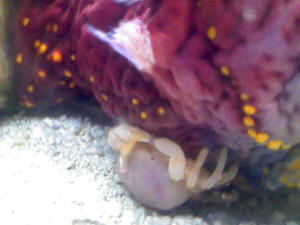 |
Crab ID please; comp. f' 4/23/13
I think I have the same crab as a previous request for ID who sent a
photo.
Here is a copy of the request.
Reef Aquarium Hitchhiker Crab ID Needed? 9/26/08
Hello, I wondered if you could identify this crab?
Thank you in advance~
<Mmm, I can't seem to find in my ref.s... Can you wait a till 10/6 or
so?
Will ask LynnZ to look at. BobF>
I hope it is ok to do this.
<<Ah yes; referring to others work (in this case a photo) is fine>>
The crab came with a new piece of live rock and stays in a crevice usually
only waving a claw out to pick things of the rock. I have, however seen
it just out a couple of times but only for a matter of seconds and no
time to take a photo. It is very similar to the picture above. It has
faintly striped legs like a Pom Pom, a dark oval carapace which is about
10 mm across and has markedly unequal claw size which are quite long for
the size of the crab. It has a delicate claw with a thin arm and a much
more heavily built one, again, very similar to above. I would be glad to
know if I can leave it in my small 30 L Nano tank as it will be very
difficult to catch.
<<I would likely leave it there for now... All decapods/true crabs are
opportunistic, will try to eat other animals; but this one is small, may
stay small, not pose a problem. If trouble, it can be baited/removed
later>>
Nevertheless, I do not want it to damage my barnacle blenny (he's quite
tough) or my blue stripe pipe fish who keeps sticking his head in its
lair.
Any advice would be greatly appreciated.
<<You have it. T'were it me/mine, I'd hold off on removal at least for
now.
Bob Fenner>>
Re: Crab ID please, another lifted pic
4/26/13
Hi Bob Fenner,
Thanks for your reply and I will follow your advice. I think I have
tracked it down as Tanaocheles bidentata on an obscure online
classification book which happened to include a photo
<I see this>
This is identical as far as I can see but info for it, on the net, is
very scarce with nothing more than its taxonomy classification. I was
hoping to find out something about its habits and its likely fully grown
size. If you have any info on this crab I would be interested to hear.
Thanks again for your help and great website.
Regards
Max
<I do not; but thank you. BobF>
|
Malevolent Crab? 4/2/13
Dear crew
<Hello, Lynn here today.>
I have a few of these crabs in my reef tank and don’t know if they are
the kind I should have in there or not.
<The short answer is no, since, at least the one photographed, is a
“true” crab (brachyuran: two claws + 4 pairs of walking legs) as opposed
to a porcelain/”false” crab (Anomuran, family Porcellanidae: 2
claws + 3 pairs of walking legs). Brachyurans can have leanings
towards various foods but they’re opportunistic omnivores that will eat
just about anything when hungry and/or given half a chance.
The longer answer involves examining the claws in order to get a better
idea of a crab’s main diet. Judging from what I see in the photo,
your crab most likely has spoon/spatulate-shaped claw tips. It’s
believed that these are useful for scraping algae, etc., off hard
surfaces, grasping filamentous algae, and/or scooping up soft materials
(e.g. detritus and/or coral mucus). It would be nice if these claw
tips were indicative of a single family or genus, but they are found in
many. These crabs tend to be a bit better risk in reef tanks than
say, a large, heavy-clawed Xanthid, or a more slender, sharp-clawed
Portunid (swimming crab), but by no means does this make them “safe”.
They're still opportunistic omnivores that may be fairly well-behaved
when small and well fed, but can be a problem later on as their bodies
and appetites grow, and competition for food increases.>
I did not purchase them. I guess they would be around 6 years old.
<I can’t tell how large the one is in the photo, but even if the crabs
you have are a smaller species, they are still capable of damaging
livestock.>
They only come out at night. I've lost a few small fish and can't
seem to keep any shrimp around. I figured maybe these crabs are
the reason why.
<That could be part of it, especially if the crabs are able to grab a
shrimp when it's vulnerable during a molt.>
Any thoughts?
<Yes, if possible, I would trap/capture the crabs and find them a new
home in a sump or elsewhere. Please see WWM regarding crab removal (3
pages, starting here:
http://www.wetwebmedia.com/swcrabcomp.htm >
Thank You
<You’re most welcome.>
L. Splitter
<Take care, Lynn Z>
|
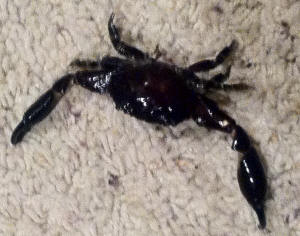
Re: Malevolent Crab? 4/4/13
Thanks Lynn.
<You’re very welcome.>
The crab, with its arms extended is about a 5 inch span.
The head is about 1.5 inches across.
<Whoa, yep, I’d be finding those crabs a new home! Take care, Lynn Z>
|
|
What is this crab –
02/20/13
We found this crab washed up on the beach on Ft Myers Beach Florida and
would like to identify it. Also, as it has been sitting out in the sun
for days, it is dry. Is there a way to safely preserve this crab,
such as incase in a plastic cube. We would love to save it as a
memory of our trip. Thank you.
Any idea?
Re: What is this crab
Yep, I'm pretty sure I know what that is. I'll get on it right
away.
-Lynn
<Thank you. B>
What is this crab? Persephona mediterranea – 2/20/13
We found this crab washed up on the beach on Ft Myers Beach Florida and
would like to identify it.
<It’s a common species called Persephona mediterranea, aka the “Mottled
Purse crab”, in the family Leucosiidae. For more information,
please see the FAQ titled “Crab: Persephona mediterranea - 3/22/11” at
the following link:
http://www.wetwebmedia.com/twafaqs2.htm?h= >
Also, as it has been sitting out in the sun for days, it is dry.
Is there a way to safely preserve this crab, such as encase in a plastic
cube? We would love to save it as a memory of our trip.
<I’ve brought home many a small crab carapace, but never a whole crab
(that I wasn’t going to eat!), so the best I can do is recommend
an internet search for (hopefully) more reliable results. In the
meantime, I’d do a sniff test. Basically, if the crab smells to
high heaven then you’ll definitely need to do something about the
rotting flesh inside. That is, either find a way to dissolve or
desiccate/mummify it. If there’s very little to no smell at all,
I’d leave the crab out awhile longer in a dry, open area, just to be
sure all moisture it gone, then encase it if you like. In the
meantime, here’s something from a taxidermy site:
http://www.taxidermy.net/forums/BeginnersArticles/00e/0086A63B9C.html
Thank you.
<You’re very welcome and good luck with your project! Take care,
Lynn Z>
|
[1].jpg) |
|
Crab ID and Anatomical Question: Probable Xanthid
/LynnZ – 12/12/12
Hi wonderful experts!
<Hello there, Tim and thanks! I’m not sure that I fit into the expert
category but there are certainly those here that do!>
This crab arrived on my live rock about a year ago, not much bigger than
a pistachio.
<It’s a neat-looking little crab.>
Now he's about 2 1/2 inches wide and still growing. He's in a tank
with just one fish, a flame Hawkfish. I worry that the fish may be
in danger.
<I can certainly understand that. Crabs are opportunistic
omnivores that pose an increasing risk to fish, snails, etc., as their
size and appetite grow.>
I've looked closely at his claws.
<Excellent, you can tell a lot about a crab by studying the shape of its
claws and legs.>
They are strong but short and cannot open wider than about 1/4 inch,
maybe not even that far. Also, they are blunt and knobby, not
sharp at all. I suspect that he normally eats small snails.
<I can’t quite see the claws all that well, but in general, robust
versions with large, knobby/blunt “teeth” (referred to as “molariform” =
molar-like) are typically used to break through shells, (e.g. Mollusks,
other crabs, etc.). Sometimes these crabs will have one large claw
for crushing and another, smaller one, for picking and/or cutting.>
I feed him krill, and I've got him trained to come out and beg for food
that I give using long tweezers.
<Good, those claws can put some serious hurt on you so keep the
tweezers/tongs handy!>
Anyhow, I have three questions, if I may:
1) Given that his claws are short and blunt, do you think he'd be apt to
kill my Hawkfish?
<It’s possible if the fish was unhealthy/compromised in some way, or
maybe at night, if the fish was at rest, and cornered. Even with
blunt claws, a crab can still grasp something, hang onto it and kill it.
Again, the risk factor increases with the crab’s size and appetite so be
sure to keep it well-fed.>
2) Can you perhaps ID him from these two pictures?
<Hmmm well, I suspect that it’s a Xanthid of some sort, but that’s as
far as I can take it. Even if I knew exactly where the crab came
from originally, and had it right in front of me, it would still be a
daunting task to get a concrete ID. There are just too many genera
and species out there and each can vary to a surprising degree.
Suffice it to say that it’s a pretty little crab, but do keep an eye on
it because it could get very big and very hungry!>
3) I can't figure out where his eyes are.
<They’re large, white, with small pupils, located at the front edge of
the carapace. The arrow on the right side is aimed directly at
one. >
He has a pair of central 'antennae' that are long, thin, very flexible,
and constantly flit about. Are those tiny eyestalks?
<If you’re referring to the thick(-ish) appendage where the left arrow
points, no, that looks like either one of the crab’s antennules (small
antennae) or one of the many mouthparts. The front end of a crab
is a mixture of many moving parts, including the eyes (sometimes on long
stalks), one pair each of antennae and antennules, and a host of
mouthparts including three pairs of specialized feeding appendages known
as maxillipeds, two pairs of maxillae, and one pair of mandibles.
Please see the following link for diagrams and more information
regarding crab anatomy:
http://lanwebs.lander.edu/faculty/rsfox/invertebrates/callinectes.html
He also has a further apart pair of eyelike things on his shell. I
marked one of each of these on the first photo. Thoughts?
<Heheee, yep, the eye-like things are eyes! The object at the left
arrow is mentioned above.>
Thank you very much!
<You’re very welcome!>
Tim
<Take care, Lynn Z>
Crab ID and anatomical question /BobF
12/12/12
Hi wonderful experts! This crab arrived on my live rock about a
year ago, not much bigger than a pistachio. Now he's about 2 1/2
inches wide and still growing. He's in a tank with just one fish,
a flame Hawkfish. I worry that the fish may be in danger.
I've looked closely at his claws.
They are strong but short and cannot open wider than about 1/4 inch,
maybe not even that far. Also, they are blunt and knobby, not
sharp at all. I suspect that he normally eats small snails.
I feed him krill, and I've got him trained to come out and beg for food
that I give using long tweezers.
Anyhow, I have three questions, if I may:
1) Given that his claws are short and blunt, do you think he'd be apt to
kill my Hawkfish?
<Not unless the crab gets, is much larger, no>
2) Can you perhaps ID him from these two pictures?
<Due to overall shape, coloration/marking, am guessing this is a member
of the genus Lissocarcinus>
3) I can't figure out where his eyes are.
<The one on the right you have labeled...>
He has a pair of central 'antennae' that are long, thin, very flexible,
and constantly flit about. Are those tiny eyestalks?
<Not; these are antennae:
http://library.thinkquest.org/26153/marine/arthro.htm >
He also has a further apart pair of eyelike things on his shell. I
marked one of each of these on the first photo. Thoughts?
<As stated, one of the eyes>
Thank you very much!
Tim
<Welcome! Bob Fenner>
|
.JPG)
.JPG) |
Re: Crab ID and Anatomical Question:
Probable Xanthid – 12/13/12
Lynn - Thank you!
<You’re very welcome, Tim, it was my pleasure!>
The link you sent is wonderful... I printed a hard copy for detailed study.
<Excellent! I’d hoped that you would find it as useful as I have over the
years. When you have a chance, do check out the site’s other
listings as well, as they include Aiptasia, various snails, sponges,
tunicates, peanut worms/Sipunculans, sea stars, Cukes, etc. It really
is a wonderful site:
http://lanwebs.lander.edu/faculty/rsfox/invertebrates/ >
This crab is one of the most interesting critters I've got.
<They can be very interesting indeed.>
He is very tame and comes right up to the glass to watch me. So
I can get down literally a couple inches from him and study him closely.
<That makes life a whole lot easier, doesn’t it! Trying to study an
animal that’s constantly darting around and/or hiding can make for a real
challenge!>
His anatomy is fascinating, especially his mouth, which is unlike any other
animal mouth I've ever seen.
<Yep, it’s a bit like an insect’s mouths (so many moving parts) but for some
reason, the fascination I have for marine invert’s doesn’t translate to
insects. I think it’s from watching too many “creature feature”
monster movies when I was a kid in the 60’s. Invariably, some bug - ant,
praying mantis, tarantula, grasshopper, etc., was transformed (usually due
to radiation) into a giant nightmare. Don’t get me wrong, I loved
those movies (still do), but “Them” in particular (giant ants) really
creeped me out. The only exception was the movie: Mothra, with the
giant caterpillar/moth (and the three tiny women kept in a box that sang to
him!). Anyway, to this day, I still change nature programs when they
start in on ants – Ahhhh!>
So the anatomy chart you sent will be great to have in hand while I watch
him.
<Super!>
As a bonus, I had a minor problem with Valonia in that tank, and he's
cleaning it up! I knew that Mithrax crabs do that, but this guy is
doing a very thorough job of it.
<Yay!>
So, I'm going to keep him well fed and just hope my Hawkfish stays alert.
<Yes indeed, do keep an eye on the two and if at some point, the crab gets
large enough to take the tweezers along with the food, it might be time to
find it another home!>
Tim
<Take care, Lynn Z> Re: Crab ID and
anatomical question 12/13/12
Bob - As always, thank you very much for all the info. I've made note
of "Lissocarcinus" and I'll see if I can track down some more info on that
particular genus.
<Ahh, tis only a guess Tim>
I'm also happy that you are not too worried about my Hawkfish. This
may be heresy, but if I had to get rid of one or the other, I'd be more
inclined to keep the crab!
<D'oh!>
That guy is fascinating to watch. When I turn off the pumps, he comes
flying out of his hiding hole and begs for food like a puppy. I also
love the fact that he voraciously eats Valonia, which would probably take
over this tank if it weren't for him. Funny how some tanks favor
Valonia, and others don't.
Tim
<Cheers (and happy holidays), BobF>
|
|
Marine Crab Identification 11/12/12
Hello Wet Web Crew,
I'm trying to identify a Crab that's in my 30gal Saltwater Tank. I attached
three pictures of it (below). It's very small, with a white body, orange
legs, and orange eyes. I think its nocturnal as it does not come out much
during the day. I've spent hours searching forums trying to ID this little
guy and have come up blank. Any idea what he is?
I'm trying to start a reef tank and would like to know if he'll be safe to
keep or not.
Thanks so much,
Roberta
<Roberta; your pix didn't "come over". Please re-send as attachments... and
try sending to yourself as well...
Cheers Bob Fenner>
|
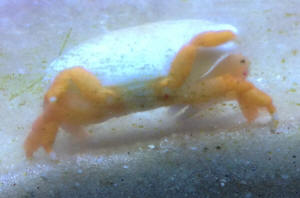
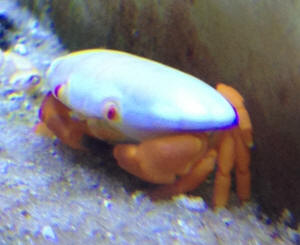 |
Re: Marine Crab Identification
11/12/12
<A nine meg file?! Moan... >
I'm so sorry! Should be attached now.
<This looks to be a Pinnotherid of some sort... Pinnixa species? Usually
commensal in bivalves... BobF>
Re: Marine Crab Identification
11/12/12
Thanks so much!
I am researching them now.
<Ahh, if this is a Pinnotherid (introduced via a clam likely...) not likely
to live long. B> |
|
Mystery Crab ID? 6th November 2012
Good Morning Crew!
<Hi Paul>
Last night, I finally managed to catch a hitchhiker who has been bugging
me for a while! The culprit is a crab with red eyes (picture attached).
<I see this>
I know it has been responsible for the consumption of a biscuit starfish
in the past couple of months and possibly the loss of a small female
mandarin.
<Could well be>
I've searched your ID pages a couple of times and I am 99% sure that it
matches the crab on page 2, topic 'Crab ID? 12/5/03'. That was a while
ago and there didn't seem to be any definitive ID, so I thought I would
ask again.
Those red eyes.... So glad to have them out of the display and in the
sump!!
<Mmm, well; my first guess was that this might be a member of the genus
Calappa; perhaps Calappa hepatica (Linnaeus 1758). I do agree w/ the
linked image/response you cite here:
http://wetwebmedia.com/swcrabidfaq2.htm
I would isolate this animal/Decapod in any case; it's likely to consume
other life in your system>
Many thanks in advance for any help you can provide in the ID!
Kindest regards,
Paul.
<Welcome. Bob Fenner>
|
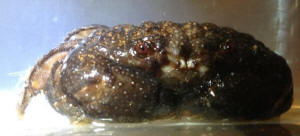 |
|
Crustacean Identification: Leucosiid Crab - 9/21/12
<Hello there, Lynn here today.>
Not sure what this crab is, NEED help!
<It appears to be some sort of Leucosiid crab (family Leucosiidae), of
which there are many genera and species. Also known as a “purse”
or “pebble” crab, these animals tend to bury themselves in the sediment
and prey on small critters that come their way. If you wish to
protect those in your display, you might want to relocate this little
fellow to a sump or find it a new home. Please see the following links
for a bit more information and representatives of the family:
FAQ titled “Crab: Persephona mediterranea - 3/22/11”:
http://www.wetwebmedia.com/twafaqs2.htm?h=
http://txmarspecies.tamug.edu/invertfamilydetails.cfm?famnameID=Leucosiidae
http://txmarspecies.tamug.edu/invertdetails.cfm?scinameID=Persephona%20crinita
>
Thanks.
<You’re very welcome. Take care, Lynn Z>
|
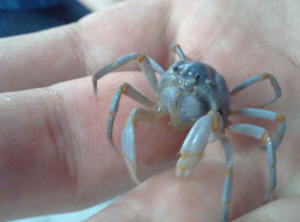 |
Re: Crustacean Identification:
Leucosiid Crab - 9/21/12
AWESOME! Thanks for the info.
<You're welcome! Take care, Lynn Z> |
|
Not your average hitchhiker crab? - 8/17/12
Hey there folks! I'm now a salty (for the past 2 month actually) after 3
years of researching. Loving my 10gallon reef more and more each day...
<Ah good>
On to my main concern/question!
Whelp was watching my 10gallon tank ...saw this little
dude in the attached pictures appear on the glass and was eating algae
and other particle matter
<For now...>
Looks exactly like a pom pom crab, except for its coloration. Maybe a
juvenile? It is very small at around 3 cm or so..
<I do think this is a juvenile... perhaps a Xanthid, given the dark
coloring of the claw tips... I wouldn't trust it around other livestock
as it grows. Bob Fenner>
|
.jpg)
.jpg) |
|
Re: Not your average hitchhiker crab?
8/18/12
ok, have it separated....future peacock mantis shrimp food!
<Hotay! BobF>
Re: Not your average hitchhiker crab?
8/19/12
Hahaha Thanks for the help Mr. Fenner!
<Welcome! B>
|
|
Hitchhiker crab ID 8/6/12
Hi WWM crew.
<Hello Ray>
I'm happy to be in the legions who find Wet Web Media the very best
source for practical aquarium knowledge. Most everything I learn
about aquarium keeping starts with research on WWM!
<Always good to hear.>
I found a beautiful little crab hitchhiker on a piece of live rock, and
would love to know family/species, if possible. (See attached
image.)
It's roughly 1" from leg-tip to leg-tip. I couldn't find a similar
crab looking through the FAQs.
<A wonderful hitch-hiker indeed! You have a Lybia tesselata aka Boxer or
Pom Pom crab. Read more here--
http://www.wetwebmedia.com/PomPomCrabF.htm?h= >
Thank you, and keep up the great work!
<Quite welcome>
Ray Sundstrom
Seattle, WA.
<Jordan
Baton Rouge, LA>
|
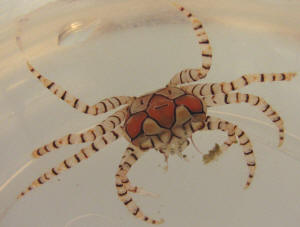 |
Hitchhiker crab ID 8/6/12
You folks are even better than I imagined.
Immediately after sending the original email, an open browser window on my
desktop had an image of a Lybia edmondsoni (Hawaiian Pom-Pom crab,)
<Definitely a Lybia sp. I suspect species tesselata but you have a better
vantage point.>
that absent the Triactis producta is a twin of my little guest.
<Their nems are often lost in transport.>
How did you do that? :)
<Magic.>
r
<Jordan>
re: Hitchhiker crab ID 8/6/12
Thanks Jordan! That was an incredibly fast and concise response.
<Anytime.>
It's been a while since I have visited Louisiana. I sure do miss it.
<It's still hot and humid but the fishing is great.>
Cheers!
<Back at ya.>
Ray
<Jordan>
re: Hitchhiker crab ID 8/6/12
I'd bet your species ID is more on the money.
<I'm fairly certain it's a L. tesselata but I'll let you be the final judge.
In any event, it's a great hitch-hiker.>
Thanks again!
<Quite welcome.> |
|
What do I have here hitchhiker from indo!
7/22/12
Hello Bob & Crew!!
<Hi Mike>
Hope all is well, I found this guy while breaking up a combo rock from
Indo.. Love the "magic mushroom" rocks they make with all the Zoas,
cloves and of course gsp on em haha! I've been finding my fair
share of sundial snails on them as I figure the snails know where their
farms/food are over there. I broke one up and looked down and here
was this guy, looked on WWM could it be in the Schizophrys family?
<Could be... looks like a decorator crab of some sort>
Any help much appreciated as always, still waiting for you to come back
out to Denver!! I'm sure I'll see ya out at macna.
<Ah yes. Look forward to it>
Mike Snyder
www.thecoralshop.com <http://www.thecoralshop.com/>
<Bob Fenner>
|
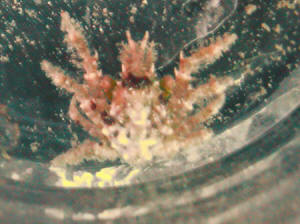
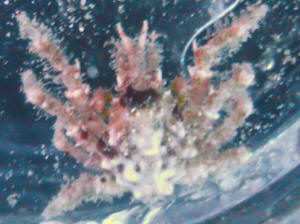 |
|
Hitchhiker Crab Identification and Relationship: Pea Crab on
Sea Apple – 5/30/12
Crew,
<Hello Kevin and Amber, Lynn here this evening.>
Two days ago we adopted a Sea Rose, more specifically I believe to be
Pseudocolochirus violaceus. His tank is currently
(and will remain) fallow.
<Good>
However, he appears to be distressed and we noticed a friend clinging to
him and even appearing to move him about. By distressed, he is
shedding a mucous like coating and has some ulceration near the oral
cavity.
<Not good>
My questions are first, can you identify the crab?
<Not to the species level, but I’ve seen this little fellow before.
It’s a Pea Crab of some sort, (Family: Pinnotheridae - many
genera/species). Please see the FAQ titled “Sea Apple Hitchhiker:
Pea Crab - 3/21/08” at the following link for more information and a
photo for comparison:
http://www.wetwebmedia.com/Arthropoda/CrustaceanPIX/SWCrabs/Crab%20IDs/swcrabid10.htm
>
Secondly, is this likely a symbiotic relationship of some sort
<I don’t believe so, no. I think the relationship (in the wild and
under normal circumstances) falls more under the heading of
commensalism. That is, one organism (the crab) benefits while the
other (the Sea Apple) is neither helped nor harmed to any significant
degree.>
…or is the crab most likely stressing him out?
<I think that at this point it might well be adding to the Sea Cuke’s
stress so I’d separate the two.>
We have searched, read, and learned a great deal about this Cuke from
your website. However, these questions remain. Of course, I am hesitant
to move the crab until we can figure out what is going on.
<I can understand that but at this point I’d separate the two.>
Thanks,
<You’re very welcome and good luck.>
Kevin and Amber
<Take care, Lynn Z>
|

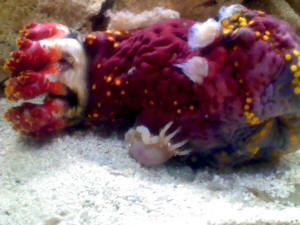 |
|
|

